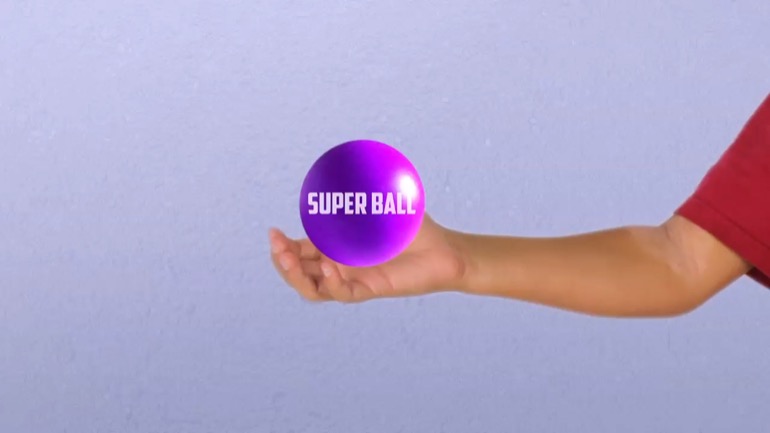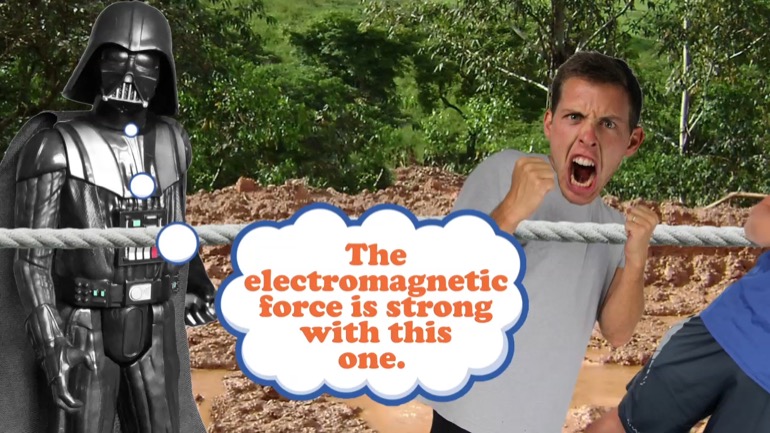ShmoopTube
Where Monty Python meets your 10th grade teacher.
Search Thousands of Shmoop Videos
Physics Videos 34 videos
Isaac Newton. Who was he? Why do we need to know about him? In a physics course, no less? Well, he's only the most famous physicist in history, and...
What are the basics of trigonometry? And why are we learning about this in a physics course? Both good questions. In this video, you'll learn about...
It's time to make our liters and meters work together. Enough of the bickering, right? In this video, we'll do some unit analysis, covering SI Unit...
Physics: Acceleration and the Pull of Gravity 8 Views
Share It!
Description:
So what's the relationship between acceleration and gravity? And where does velocity fit in? And who invited future velocity?
Transcript
- 00:03
What goes up must come down: acceleration and the pull of gravity no
- 00:24
As you've probably noticed gravity is a constant we reminded of this every time we trip on our shoelaces if it
- 00:31
wasn't for gravity we would just fly into the air when this happened which [Man flying into the air]
- 00:35
would actually be pretty cool we'd leave our shoelaces untied all the time if it
- 00:38
meant we could defy gravity even just a little bit
Full Transcript
- 00:41
well hello people I'm Isaac Newton without the annoying British accent and
- 00:46
I invented gravity okay okay it was actually just a theory that explains how
- 00:50
gravity worked and basically I figured out that everything that has mass
- 00:55
attracts everything else that has mass or to put it another way everything [Man and woman swining around]
- 01:01
attracts every other thing here on earth the biggest mass we've got is this the
- 01:07
globe that's why everything falls down toward
- 01:10
the center of the earth earth is the you know biggest thing around but what if
- 01:15
you're not standing on flat ground well let's say you're taking a hike up a hill [Woman hiking up a hill]
- 01:19
gravity is still pulling you toward the center of the Earth's core and since
- 01:24
you're on an angle on the hill this force isn't perpendicular to the ground
- 01:28
it's at an angle to the surface you're standing on the steeper the hill the
- 01:32
more acute that angle is but because we're on an incline that gravity is
- 01:36
broken into two components the first component is perpendicular to the
- 01:40
surface 90 degrees relative to the trail so that
- 01:43
component is pulling us straight down just like the gravity on a flat piece of [Gravity pulling woman towards earth's center]
- 01:47
ground well another component of gravity is pulling us parallel to the surface
- 01:52
which you're familiar with if you've ever rolled down a hill our lessons [Woman rolling down a hill]
- 01:56
lately have been all about acceleration why are we talking about rolling down a
- 02:00
hill well because gravity is a force of
- 02:02
acceleration it might take it for granted because it's always around you
- 02:06
might say it's constant because it is here on earth gravity is a constant
- 02:11
force of 9.8 meters per second squared now we can overcome that force by [Rocket appears]
- 02:17
providing a stronger force in the other direction like when a rocket launches
- 02:22
into space to get off the ground the rocket engines have to provide enough
- 02:26
force to achieve liftoff and it's the same thing when you throw a ball in the [Man throws ball in the air]
- 02:30
air your arm creates enough force for the ball to go upwards at least for a
- 02:33
little while it'll come back to earth eventually though when velocity and
- 02:38
acceleration are in opposite directions the velocity will eventually change and
- 02:42
turn in the direction of acceleration of course if velocity is strong an
- 02:47
acceleration is weak it might take a while to make that turn but if they're
- 02:51
both working in the same direction well unless another force acts on whatever
- 02:54
object is in motion the velocity will just keep on getting higher let's take a
- 02:59
look at how these forces interact well on this chart longer arrows indicate
- 03:04
greater magnitude than shorter ones and this is all about predicting the future [Velocity, acceleration and future velocity columns appear]
- 03:09
at least in the short term like we said over time acceleration will always
- 03:12
overcome velocity but as we can see with this set in the short term if velocity
- 03:17
is strong and acceleration is weak and they're acting in opposition while
- 03:22
velocity will be weakened let's look at how this plays out in a realistic
- 03:26
situation well the situation is that we're going to shoot a guy into the air [Newton puts a man into a cannon]
- 03:30
with a cannon look you have your reality and I have
- 03:34
mine the initial velocity will be 50 meters a second and we'll be pointing the
- 03:39
cannon straight up here's a graph of the guys displacement as he takes flight [Displacement graph appears]
- 03:43
well what does this graph tell us about the velocity well for one thing we know
- 03:48
he didn't have a constant velocity otherwise the line would be straight to
- 03:52
make a velocity time graph we need the slopes of the tangents to the
- 03:55
displacement graph we've already done that math and come up with this velocity
- 03:59
versus time graph right there remember if we see a linear graph for velocity it
- 04:05
means acceleration is constant acceleration is the change in velocity
- 04:09
divided by the change in time well the final velocity here was negative 48
- 04:14
meters per second and the initial velocity was 50 meters per second making
- 04:19
the change in velocity negative 98 metres per second the time elapsed was
- 04:26
10 seconds so when we divide negative 98 m/s by 10 seconds we find an [Full equations appears]
- 04:32
acceleration of negative 9.8 meters per second squared magic see the
- 04:38
acceleration of gravity is constant gravity would never let us down well
- 04:44
true it actually always lets us down anyway everything so far has been [Man falling to the ground and Newton catches him]
- 04:50
theoretical I hate to let you down but we didn't actually launch some guy out
- 04:54
of a cannon all right well why don't we do some actual science that's right it's
- 04:57
lab time all right let's get our stuff together first we need a ball have a
- 05:01
ball tennis base golf any of those will do just fine [Newton with a selection of balls]
- 05:06
we need a way to measure height we can tape some paper to the wall and mark
- 05:09
measurements here or you can use an app here's one for the iPhone and here's one
- 05:14
for you Android users and we'll need a stopwatch which you might have on your
- 05:18
phone we'll be taking notes so you'll need paper on your computer or whatever
- 05:22
and we'll trust you can figure something out and last we'll also need to make
- 05:25
graphs well there's software for that and
- 05:27
there's old-school graph paper on three hit pause and go scavenge one two three [Newton with all of the items for experiment]
- 05:32
go.... all right got everything? awesome ish ideally this will be done as a team
- 05:38
we'll need someone who's throwing the ball and someone who's taking and [Girl with the ball and boy with stop watch]
- 05:40
recording the data so we need to get organized we need a grid that lets us
- 05:45
track the height of each toss and the time between letting the ball go and
- 05:49
catching it again and we'll eventually be figuring out the velocities for each
- 05:52
toss so include a column for that too and take a few practice throws make sure [Girl throwing ball into the air]
- 05:56
you can get a good read on how high the ball is going and you want to be as
- 06:00
consistent as possible in these tosses we don't want one throw to go two meters
- 06:04
high and another to go 12 high if for no other reason and when our ceiling isn't
- 06:09
that high and we want to throw the ball as straight up as we can don't worry
- 06:12
we're just human so we know there's gonna be some degree of error here...
- 06:17
Once you've gotten that toss down we can start doing this thing for real
- 06:20
we need a minimum of three good tosses and if you've got a big group together [Girl tossing ball into air and group watches]
- 06:24
for this lab well take some more tries at it let everyone collect some of their
- 06:27
own data you can never have too much data ideally you'll be catching the ball
- 06:32
at the same height it left your hand otherwise whoever is working the clock
- 06:36
should try and stop timing when the ball returns to that same height if you make
- 06:40
a bad toss don't worry about it just don't include the data in that toss in
- 06:43
your chart we're gonna be doing some graphing now you know we're pretty
- 06:46
stoked too, can you tell? any graph we make needs a starting point well for a
- 06:50
displacement graph we can have a starting point at zero since the ball is [Displacement graph appears]
- 06:54
coming back to the same position it started from but what about velocity
- 06:57
well when we've seen velocity graphs before
- 07:00
they've usually started with an initial velocity of zero but the ball is
- 07:05
already moving when you let it go so we got to figure out what the initial
- 07:09
velocity is all right good news we've got an equation for that here it is in [Initial velocity equation appears]
- 07:13
this equation the change in displacement which is that Delta X thing right there
- 07:18
equals the initial velocity times the elapsed time that's the V sub zero thing
- 07:23
and the T there plus one half acceleration aka A multiplied by the
- 07:29
square of the time period that's the equation we know our change in
- 07:33
displacement equals zero so we can put that into our equation and now we can
- 07:37
solve for initial velocity let's start by subtracting the last part of our
- 07:41
equation one half A T squared from each side leaving us with negative one half A
- 07:48
T squared equals V sub 0 times T now we can divide both sides by T to isolate
- 07:54
initial velocity so the initial velocity equals the negative of one half
- 07:58
acceleration times T our acceleration is negative 9.8 meters per second squared
- 08:04
and cutting that in half gives us negative four point nine meters per
- 08:08
second squared but we need the negative of that number so now we've got a [Acceleration formula appears]
- 08:13
positive number of 4.9 and since time will be in units of seconds we know that
- 08:19
will cancel out one of those seconds in meters per second squared and we'll have
- 08:24
the right unit for velocity so our starting velocity equals 4.9 times T
- 08:30
well it's important to remember that once the ball leaves our hand gravity is [Girl throws ball into the air]
- 08:34
the only force that's being applied to it even though it's moving up and
- 08:37
doesn't last very long so when we do our graphs for the data we collected we can
- 08:41
be confident that the acceleration versus time graph will be flat which
- 08:46
means the velocity versus time graph will be linear
- 08:48
now let's do the graphs for each throw we made oh but before we do let's think
- 08:53
of one more thing if we have our velocity correct and we have our time
- 08:57
period correct we can calculate the max displacement let's take another [Displacement graph appears]
- 09:01
look at our graph for cannon guy well we can see that this looks pretty
- 09:05
symmetrical right and the highest point with the most displacement is halfway
- 09:10
through the journey there since velocity equals the change in displacement over
- 09:16
the change in time we can rearrange the equation to solve for displacement the
- 09:21
change in displacement equals the velocity times the time halfway through
- 09:24
the ball's whole journey but this is all in theory go ahead and find the
- 09:28
theoretical max height for some of your throws and compare that to what you
- 09:31
actually measure is the max height which do you think is more accurate do you [Recorded height and theoretical max height readings appear]
- 09:36
think you measured the height wrong did you not get the time quite right
- 09:40
throwing off the velocity again don't expect yourself to get any of this
- 09:44
perfect it's more important to be able to think through any errors we've made
- 09:48
okay for reals now put that pause button to use and get graphing compare your
- 09:52
graphs for each throw do they look like what you expected if you worked as a
- 09:57
team do your graphs look like those your colleagues drew and while we're thinking [Colleagues holding graphs]
- 10:01
about this stuff let's think about some other stuff too what determines how long
- 10:05
the ball is in the air what's the acceleration when the ball is stopped at
- 10:10
the peak of its arc and what do we have to eat around here [Tennis ball transforms into an apple]
- 10:13
okay well that last ones just means we're getting hungry so let's wrap this
- 10:18
thing up but yeah it's important to exert some
- 10:20
brainpower on these questions there's no point in doing an experiment and taking
- 10:23
down data if we don't understand what it means and if you're feeling super
- 10:27
ambitious write up a whole report but for now it's snack time, oh an apple for
- 10:32
Isaac Newton yeah very funny [Boy gives Newton an apple]
Related Videos
When you're about to marry the love of your life, not many things could stop you. However, finding out that your future hubby is keeping his crazy...
Here at Shmoop, we work for kids, not just the bottom line. Founded by David Siminoff and his wife Ellen Siminoff, Shmoop was originally conceived...
ACT Math: Elementary Algebra Drill 4, Problem 5. What is the solution to the problem shown?
AP® English Literature and Composition Passage Drill 1, Problem 1. Which literary device is used in lines 31 to 37?
AP® English Literature and Composition Passage Drill 2, Problem 1. What claim does Bacon make that contradicts the maxim "Whatsoever is delig...






































